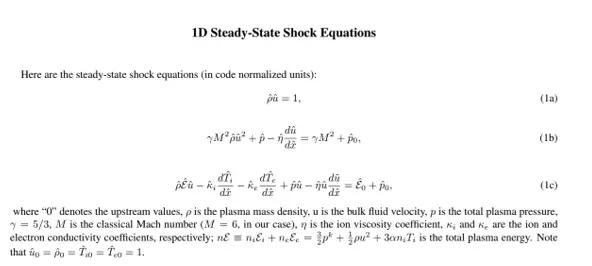Instructions
Objective
Write a python assignment program to implement steady state equations.
Requirements and Specifications

Source Code
import numpy as np
import matplotlib.pyplot as plt
M = 5.0
gam = 5./3.
# ==========================================================================
# ==========================================================================
def ddx(x, F):
Ns = F.size - 1
dFdx = np.zeros(Ns + 1, dtype='double')
dFdx[0] = (F[1] - F[0]) / (x[1] - x[0])
for i in range(1, Ns):
dFdx[i] = (F[i + 1] - F[i - 1]) / (x[i + 1] - x[i - 1])
dFdx[Ns] = (F[Ns] - F[Ns - 1]) / (x[Ns] - x[Ns - 1])
return dFdx
# ==========================================================================
# ==========================================================================
if __name__ == '__main__':
electron = np.loadtxt('./electron_quantites.txt')
ion = np.loadtxt('./ion_quantites.txt')
x = electron[:,0] # positions
rho = ion[:,1] # this is rho/rho0.
ke = electron[:,2]
Te = electron[:,1]
Ti = ion[:,2]
ki = ion[:,3]
eta = ion[:,4]
u = ion[:,5]
p = ion[:,6]
E = ion[:,7]
# First, calculate du/dx
dudx = ddx(x, u)
# Calculate dTi/dx
dTidx = ddx(x, Ti)
# Calculate dTe/dx
dTedx = ddx(x, Te)
# From equation (1b), calculate p0u0^2 + p0
eq1b = p + gam*M**2.*rho*u**2. - eta*dudx
eq1b_right = gam*M**2 + p[0]
# Equation (1c)
eq1c = E*u + p*u - ki*dTidx - ke*dTedx - eta*u*dudx
eq1c_right = E[0]/rho[0] + p[0]
# Eq. 1a
eq1a = rho*u
#==========================================================================
#==========================================================================
# create plot
plt.figure(figsize=(7,7))
# Plot dTidx
plt.plot(x, rho, label = r'$\rho$')
plt.plot(x, ke, label = '$k_{e}$')
plt.plot(x, Te, label = '$T_{e}$')
plt.plot(x, Ti, label = '$T_{i}$')
plt.plot(x, ki, label = r'$k_{i}$')
plt.plot(x, eta, label = r'$\eta$')
plt.grid(True)
plt.xlabel('Position')
plt.legend()
plt.show()
plt.figure(figsize=(7,7))
plt.plot(x, u, label = 'u')
plt.plot(x, p, label = 'p')
plt.plot(x, E, label = 'E')
plt.plot(x, dudx, label = r'$\frac{du}{dx}$')
plt.plot(x, dTidx, label = r'$\frac{dT_{i}}{dx}$')
plt.plot(x, dTedx, label = r'$\frac{dT_{e}}{dx}$')
plt.xlabel('Position')
plt.grid(True)
plt.legend()
plt.show()
"""
Now, plot each terms of each equation
"""
# Terms for Equation (1a)
plt.figure()
plt.plot(x, rho*u, label = r'$\rho u$')
plt.xlabel('Position')
plt.ylabel(r'$\rho u$')
plt.set_title('Equation (1a)')
plt.legend()
plt.grid(True)
plt.show()
# Terms for question (1b). All terms in the same Figure
# p + gam*M**2.*rho*u**2. - eta*dudx
fig, axes = plt.subplots(nrows = 1, ncols = 2, figsize=(7,7))
axes[0].plot(x, p, label = r'$p$')
axes[0].plot(x, gam*(M**2)*rho*(u**2), label = r'$\gamma M^{2}\rho u^{2}$')
axes[0].plot(x, -eta*dudx, label = r'$-\eta \frac{du}{dx}$')
axes[0].plot(x, eq1b, 'r--', label = r'$p + \gamma M^{2}\rho u^{2} - \eta \frac{du}{dx}$')
axes[0].grid(True)
axes[0].set_title('Left-side terms of Equation (1b)')
axes[0].legend()
axes[1].plot(x, gam*(M**2)*np.ones(len(x)), label = r'$\gamma M^{2}$')
axes[1].plot(x, p[0]*np.ones(len(x)), label = r'$p_{0}$')
axes[1].plot(x, eq1b_right*np.ones(len(x)), 'r--', label = r'$\gamma M^{2} + p_{0}$')
axes[1].grid(True)
axes[1].set_title('Right-side terms of Equation (1b)')
axes[1].legend()
plt.show()
# Terms for Equation (1c).
# E*u + p*u - ki*dTidx - ke*dTedx - eta*u*dudx = E[0]/rho[0] + p[0]
fig, axes = plt.subplots(nrows = 1, ncols = 2, figsize=(7,7))
axes[0].plot(x, E*u, label = r'$Eu$')
axes[0].plot(x, p*u, label = r'$pu$')
axes[0].plot(x, -ki*dTidx, label = r'$-k_{i} \frac{dT_{i}}{dx}$')
axes[0].plot(x, -ke*dTedx, label = r'$-k_{e} \frac{dT_{e}}{dx}$')
axes[0].plot(x, -eta*u*dudx, label = r'$-\eta u \frac{du}{dx}$')
axes[0].plot(x, eq1c, 'r--', label = r'$Eu + pu - k_{i} \frac{dT_{i}}{dx} - k_{e} \frac{dT_{e}}{dx} - \eta u \frac{du}{dx}$')
axes[0].grid(True)
axes[0].set_title('Left-side terms of Equation (1c)')
axes[0].legend()
axes[1].plot(x, E[0]/rho[0] *np.ones(len(x)), label = r'$\frac{E_{0}}{\rho_{0}}$')
axes[1].plot(x, p[0]*np.ones(len(x)), label = r'$\rho_{0}$')
axes[1].plot(x, eq1c_right*np.ones(len(x)), 'r--', label = r'$\frac{E_{0}}{\rho_{0}} + \rho_{0}$')
axes[1].grid(True)
axes[1].set_title('Right-side terms of Equation (1c)')
axes[1].legend()
plt.show()
fig = plt.figure(figsize=(7, 5), dpi=120)
plot = plt.plot(x, (eq1b-eq1b_right)/eq1b_right*100., 'royalblue', linestyle='--', label='Eq. (1b) percent error')
plot = plt.plot(x, (eq1c-eq1c_right)/eq1c_right*100., 'tomato', linestyle='-', label='Eq. (1c) percent error')
plot = plt.plot(x, (eq1a - 1.0)/1.0 *100, 'purple', linestyle='-', label = 'Eq. (1a) percent error')
plt.ylabel(r'Percent error [%]')
plt.xlabel(r'Position $\hat{x}$')
#plt.xlim([25.0, 32.5])
plt.xlim([min(x), max(x)])
legend = plt.legend(loc='best', shadow=False, fontsize='small')
#plt.savefig('equation_error.eps', format='eps', dpi=1000)
plt.grid(True)
plt.show()
plt.close()
#==========================================================================
#==========================================================================
Similar Samples
Explore our diverse range of programming samples at ProgrammingHomeworkHelp.com. From Java to Python, C++, and beyond, our samples demonstrate proficiency across various languages and concepts. Each solution exemplifies our commitment to accuracy, clarity, and timely delivery. Whether you're a student or professional seeking guidance, our samples serve as a testament to our expertise in solving complex programming challenges. Visit us today to view our comprehensive samples and experience our top-notch programming assistance firsthand.
Python
Python
Python
Python
Python
Python
Python
Python
Python
Python
Python
Python
Python
Python
Python
Python
Python
Python
Python
Python